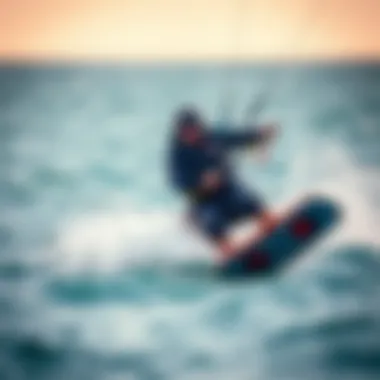Cold Water Wetsuits: A Kiteboarder’s Essential Guide


Intro
Cold water kiteboarding presents its own charm, but it also comes with challenges. One of the most significant factors in facing those chilly waters is the wetsuit. For kiteboarding enthusiasts, a proper cold water wetsuit isn’t just an accessory; it’s a game changer that can make the difference between an exhilarating experience and an uncomfortable outing.
The world of wetsuits can feel a bit like a maze with various types, materials, and features. It's essential for kiteboarders to understand what to look for to ensure they stay warm, comfortable, and safe while gliding through the waves. As temperatures dip, and as you venture into the depths of your kiteboarding journey, this guide provides a solid foundation in everything you need to know about cold water wetsuits.
From the nitty-gritty of gear selection to maintenance tips that’ll keep your equipment in prime shape, we cover it all. Understanding wetsuit technology is crucial for anyone aiming to excel in the sport, especially regardings kakdboarding in colder climates.
Gear and Equipment
Essential Kiteboarding Gear: A Comprehensive Guide
In the realm of kiteboarding, gear selection can be the defining factor of your success. Amongst the plethora of gear, the wetsuit stands tall as a vital part of your kit. When choosing a cold water wetsuit, be mindful of key factors: thickness, material, fit, and seam construction.
Thickness: Cold water wetsuits typically come in thicknesses ranging from 3mm to 6mm. A thicker suit, like a 5/4mm, provides more insulation, making it ideal for very low temperatures. Conversely, a 3/2mm wetsuit might suffice for slightly warmer waters.
Material: Neoprene remains the industry standard, known for its buoyancy and stretchability. However, advancements in technology have introduced limestone-based neoprene, which not only offers similar performance but also minimizes environmental impact. Some brands, like O'Neill and Rip Curl, have pioneered this technology to enhance performance.
"Choosing a wetsuit that fits well is like finding the right dance partner: it should move with you, not against you."
Fit: The fit must be snug, yet comfortable. A suit that’s too loose will allow cold water to seep in, defeating its purpose. On the other hand, a suit that's too tight can restrict movement and circulation.
Seam Construction: Pay close attention to how seams are constructed. Flatlock seams are comfortable but let in some water, whereas sealed seams, though pricier, prevent water from intruding. This little detail can greatly affect your riding experience in cold waters.
Maintenance Tips for Kiteboarding Equipment
Keeping your wetsuit and other gear in good condition is paramount. Here are some practical tips to prolong the life of your kit:
- Rinse After Use: Always rinse your wetsuit in fresh water after each use. Salt, sand, and chlorine can degrade the material and seams over time.
- Dry Properly: Hang your wetsuit in a shaded area to dry. Avoid direct sunlight, as it can damage the neoprene.
- Store Wisely: When not in use, hang your wetsuit on a wide hanger to maintain its shape. Folding it can create creases that might weaken the material.
- Inspect Regularly: Look for any signs of wear or damage before heading out. Early detection can save you from an uncomfortable experience on the water.
As kiteboarders, we have the privilege of embracing nature, no matter the temperature. Equipped with the right information and gear, you can venture into colder waters without trepidation.
Prologue to Cold Water Wetsuits
In the world of kiteboarding, where passion meets the elements, a properly fitted cold water wetsuit can be the difference between a thrilling adventure and an uncomfortable experience. As enthusiasts, we often chase the winds across frosty waves, pushing our limits. However, navigating these chilly waters without the right gear could hinder performance or even jeopardize our safety. Thus, understanding cold water wetsuits is crucial for anyone looking to enjoy kiteboarding in cooler climates.
When considering a wetsuit, the first thought often revolves around warmth. However, it's much more than just staying cozy. A suitable wetsuit provides buoyancy, protects against abrasions from equipment and marine life, and as it hugs the body, it enhances your agility on the board. Choosing the right wetsuit not only ensures that you can maintain a steady focus while enjoying your time on the water, but it also plays a pivotal role in your overall riding experience.
Moreover, the advancements in wetsuit technology have led to various specialties within this gear category, making it vital to approach your selection with a clear understanding of your needs. From materials to designs, each aspect serves its specific purpose. This guide aims to delve into the significant elements of cold water wetsuits, ultimately aiding kiteboarding enthusiasts in making informed decisions for their next outing.
Types of Cold Water Wetsuits
Kiteboarding doesn't stop just because the water gets a bit chilly. In fact, this extreme sport thrives in diverse conditions, which is why selecting the right wetsuit becomes paramount. The types of cold water wetsuits available significantly influence comfort, warmth, and flexibility, which are all critical factors while out on the ocean or river. Understanding the nuances of each wetsuit type ensures that enthusiasts can choose the one that best suits their individual needs, whether they're cutting through frigid waters or braving unpredictable weather.
Full Wetsuits
Full wetsuits, often considered the stalwarts of cold water gear, cover the whole body from neck to wrists and ankles. They are designed primarily for maximum thermal protection and are typically constructed from thicker neoprene, usually between 3mm to 6mm, depending on water temperatures.
These suits excel in retaining body heat, making them ideal for conditions where the water temperature dips below 60°F (15°C). The snug fit helps minimize water exchange, keeping surfers warm during prolonged exposure. However, a word of caution: full wetsuits can be bulky. Therefore, choosing the right size is crucial. A well-fitting suit should be snug but not suffocating, allowing for freedom of movement essential for kiteboarding.
Shorty Wetsuits
Shorty wetsuits, or shorties as some call them, are a perfect blend of warmth and flexibility. Covering the torso and extending only to the knees or elbows, these suits are ideal for those warm but breezy days when full coverage isn't necessary. With thickness typically around 2mm to 3mm, shorties provide some insulation without being overly heavy.
They allow for better mobility and are easier to put on and take off, which is a treat for those always on the go. However, they do provide less warmth than full suits, making them best for temperatures above 60°F (15°C). For kiteboarding, shorties are best utilized during the shoulder seasons, where warmth is needed without sacrificing movement.


Semi-Dry Suits
Semi-dry suits are somewhat of a happy medium between full wetsuits and dry suits. These suits are crafted with seals and zippers that help retain warmth yet are not entirely watertight. Most are made with higher-quality neoprene than standard wetsuits, providing better insulation and comfort.
Generally, these suits are slightly thicker than shorties but not as thick as full wetsuits, making them versatile. They can handle cooler water while also accommodating the need for mobility. Kiteboarders using semi-dry suits often find them effective for sessions where water temperatures fluctuate, as they strike a balance between heat retention and ease of movement.
Dry Suits
If avoiding chill altogether is your top priority, dry suits are unparalleled. Unlike traditional wetsuits, which allow water to enter and warm up thanks to your body heat, dry suits are completely sealed and prevent any water from making contact with the skin. Made from durable, waterproof materials like Gore-Tex, they are often equipped with layers underneath to enhance comfort and warmth.
Although there's a bit of a learning curve for suit usage—especially with zippers and layering—kitesurfers who choose dry suits can venture out into considerably colder water without the dread of hypothermia lurking nearby. These suits are often more expensive, but for those doggedly determined to kiteboard year-round, the investment can be worth its weight.
"Choosing the right wetsuit is as crucial as the kite you fly; it can make or break your experience on the water."
In summary, understanding the different types of cold water wetsuits enables kiteboarding enthusiasts to make an informed decision based on their specific conditions and personal preferences. Whether opting for the comprehensive coverage of a full wetsuit, the flexibility of a shorty, the middle-ground appeal of a semi-dry suit, or the total protection offered by a dry suit, knowing what each type brings to the table is essential for a fantastic ride when temperatures dip.
For more details, you may want to refer to these resources: Kiteboarding Wikipedia, The Balance - Choosing a Wetsuit, KiteForum Community.
Key Features to Consider in Cold Water Wetsuits
When kiteboarding in cold waters, the right wetsuit is crucial for both comfort and safety. Not all wetsuits are created equal, and understanding their essential features can greatly enhance your time on the water. Choosing the right wetsuit isn't just about keeping warm; it can also impact your performance, flexibility, and overall enjoyment while kiteboarding.
Material and Thickness
The material and thickness of a wetsuit play a significant role in its thermal insulation capabilities. Most cold water wetsuits are made from neoprene, a material that insulates well while providing some level of flexibility. When selecting a wetsuit, consider the thickness, typically measured in millimeters. A 5/4mm thickness is quite common for very cold waters, offering a good balance of heat retention and movement.
High-quality neoprene can stretch, giving you ample room to maneuver while kiteboarding. Thinner neoprene layers generally provide better flexibility, which can be beneficial for advanced maneuvers. However, it's important to ensure that the thickness is adequate for the temperature of the waters you'll encounter.
Seam Construction
Seams in wetsuits are not just there for structure; they also influence warmth and durability. Common seam types include flatlock, glued, and blindstitch. Flatlock seams are the least water-resistant and best for warmer climates, whereas glued seams are more reliable in colder environments, stopping water from trickling in.
Blindstitch seams are a step further, offering even greater insulation by ensuring minimal water entry. Moreover, taped seams can enhance the longevity of the wetsuit, providing extra strength where it matters most. As you browse through options, keep an eye on the seam construction to guarantee it aligns with your cold water needs.
Zipper Type and Placement
The zipper is another fundamental component, impacting both convenience and heat retention. Wetsuits come with various zipper styles, including back, chest, and no-zip designs. Back zippers are typical and allow for easy donning and doffing, but they can sometimes let in water if not sealed well.
Chest zippers are popular for their ability to minimize water entry while ensuring a snug fit around the neck, which is essential during those chilly sessions in the waves. Likewise, no-zip wetsuits can enhance flexibility and warmth, though they can be trickier to put on. Analyze which zipper type fits your personal preference for ease of access combined with waterproofing.
Fit and Flexibility
A proper fit is paramount. A wetsuit that is too loose will let cold water flow in, defeating its insulating purpose. Conversely, if it’s too tight, it can restrict movement. Ensure to try on multiple brands and styles as sizing can vary widely. It’s crucial to look for a snug fit around the wrists and ankles to keep the water out, while still allowing for movement in the shoulders, chest, and legs.
Flexibility is further influenced by the wetsuit design. Many modern designs offer articulated limbs, which allow for better active movement. Additionally, features like internal linings can enhance comfort and thermal retention without adding bulk. Finding the right combination of fit and flexibility can significantly enhance your confidence and performance in cold waters.
"The right wetsuit can turn a daunting cold session into an exhilarating experience devoid of discomfort."
In summary, the key features to consider when selecting a cold water wetsuit revolve around material, seam construction, zipper design, and the overall fit and flexibility. Paying attention to these details can ensure that you not only stay warm and dry but also enjoy the freedom of movement necessary for skillful kiteboarding.
Selecting the Right Cold Water Wetsuit
Choosing the right cold water wetsuit isn't just a matter of picking something off the shelf. It’s an essential process that can make or break your kiteboarding experience in chilly waters. A well-fitted wetsuit can mean the difference between a thrilling day on the water and an uncomfortable one. Continually exposed to the surf and chilly gusts, kiteboarders need to be particularly discerning about their gear. So, let’s break down exactly how to go about picking a wetsuit that meets your needs, fits you well, and stays within your budget.
Assessing Your Specific Needs


Before you plunk down your hard-earned cash, take a moment to reflect on your kiteboarding habits. Consider where you normally ride. Are you hitting the lively waves off the coast of Oregon, or are you carving out space in the more forgiving waters of the Great Lakes? Each location comes with its own climate quirks and water temperature ranges.
- Water Temperature: Make sure to check local temperature averages for the months you plan to ride. Wetsuits are graded for warmth, so knowing how cold the water gets will guide your selection.
- Activity Level: If you’re prone to long sessions on the water, you might want a suit that offers more insulation. Conversely, if you kiteboard primarily in warmer conditions, a thinner suit might suffice.
- Flexibility Needs: Are you doing complex tricks or only cruising casually? A more flexible suit will allow for greater mobility but may come at the cost of warmth.
Understanding these needs is a crucial step before diving into the vast ocean of choices available.
Understanding Sizing and Fit
Fit is paramount when selecting a wetsuit. An ill-fitted wetsuit can leave you feeling like a sardine in a can, or worse, create uncomfortable chafing and increased water entry. Here’s what to keep in mind:
- Size Chart: Familiarize yourself with manufacturer sizing charts and take your measurements before heading to your local shop or placing an order online. Remember, not all brands are created equal.
- Test the Waters: If possible, try on various models in-store. Move around as if you were kiting; a little bend and stretch will give you a good feel for the fit.
- Seal it Up: Pay attention to sealing options such as cuffs and ankle closures. A good seal minimizes entry points for water. Being snug but comfortable should be the goal.
A wetsuit should feel snug and form-fitting without restricting your movement. You want it to be right as a glove but not tight enough to turn into a straightjacket.
Budget Considerations
When it comes to budget, it’s easy to get starry-eyed over high-end options loaded with features. Still, setting a realistic budget for your wetsuit is vital. Here’s a more practical approach:
- Determine Your Upper Limit: Consider what you’re willing to spend while keeping in mind that investing in quality gear can save you money in the long run. Think durability, rather than just short-term savings.
- Look for Sales and Seasonal Deals: Often, brands will have off-season sales, especially in late summer or early fall. Being patient can lead to quality gear at a fraction of the price.
- Research before Buying: Read reviews and check forums. Sometimes the best deals come from lesser-known brands that offer solid products without the hefty price tag.
Finding the right balance between quality and price can be the key to a successful purchase.
"Don’t just go for the flashiest wetsuit; seek one that matches your adventure style and comfort requirements for the long haul."
Maintenance and Care for Cold Water Wetsuits
When it comes to enjoying your kiteboarding adventures, a well-maintained wetsuit is essential for both performance and longevity. Cold water wetsuits are not just about style or warmth; the right care can extend the life of your suit, keeping it effective in protecting you from chilly waters. Ensuring that your wetsuit is treated with respect pays dividends in comfort and functionality. In this section, we dive into the nitty-gritty of maintenance, outlining the best practices for cleaning, drying, and storing your wetsuit.
Cleaning and Rinsing
One of the cardinal rules in wetsuit maintenance is regular cleaning, specifically right after use. Saltwater and chlorinated water can wreak havoc on the materials of your wetsuit, making it feel stiff and less flexible over time. Here’s what you should do:
- Rinse Thoroughly: After a session, rinse your wetsuit inside and out with fresh, cold water. This helps remove any salt and chlorine residues that can deteriorate the material.
- Soap It Up: Use a gentle wetsuit cleaner or a mild detergent. Avoid harsh chemicals or bleach; they can damage the neoprene. A good rule of thumb is to apply soap on a soft sponge and gently scrub any dirt or stains.
- Inspect for Damage: While you’re cleaning, check for any signs of wear — frayed seams or small punctures. Early detection can save you from bigger repair costs later.
Remember: A clean wetsuit not only functions better but also smells fresh, letting you focus on the thrill of kiteboarding rather than on an unpleasant odor.
Drying Techniques
Proper drying is just as important as cleaning. Leaving your wetsuit in a crumpled heap after a long day on the water can lead to malodorous growth and can also damage the suit over time. Consider the following methods for drying:
- Hang Dry: After rinsing, hang your wetsuit upside down on a wide hanger. This helps maintain its shape and prevents stretching.
- Avoid Direct Sunlight: Although it might be tempting to let it bask in the sun, prolonged exposure can degrade the neoprene. Instead, choose a shaded area with good airflow for drying.
- Rolled Method: If you’re short on space, lay the wetsuit flat on a clean towel. Roll the towel with the wetsuit inside to absorb excess moisture, then hang it to dry. This minimizes the strain on the seams.
Storage Recommendations
Finally, storing your wetsuit properly can prevent unnecessary wear and tear. Improper storage can lead to issues like creasing and degrading. Follow these tips for optimal storage:
- Use a Hanger: If you have the space, a wide hanger is best. This provides support and prevents stretching at the shoulders.
- Avoid Folding: Do not fold your wetsuit, as this can create creases that may become permanent. If space is limited, store it flat if possible.
- Temperature Control: Store your wetsuit in a cool, dry place. Excess heat can warp the material, causing it to lose its insulating properties. Try to steer clear of attics or sheds that can get too hot.
- Flat Lay: In the absence of a hanger, you can roll your wetsuit loosely and place it in a breathable storage bag, keeping it away from sharp objects that could puncture it.
Taking the time to follow these maintenance steps is not just about keeping your gear in great shape; it's also about enhancing your performance and enjoyment in the water. A well-cared-for wetsuit means better insulation, flexibility, and ultimately, a more exhilarating kiteboarding experience.
Impact of Wetsuit Technology on Performance
The world of kiteboarding demands not just skill and passion, but also the right equipment, especially when braving chilly waters. Wetsuit technology is paramount in enhancing performance, comfort, and safety for enthusiasts engaging in this adrenaline-pumping sport. This section dives deep into how various technological advancements contribute to achieving improved insulation, flexibility, and sustainability in wetsuits—elements that are essential for anyone looking to take on the waves with confidence.
Thermal Insulation Innovations


One of the most pressing concerns when kiteboarding in cold waters is maintaining core body temperature. Innovations in thermal insulation have greatly improved how wetsuits function in frigid conditions. Modern wetsuits incorporate materials such as neoprene infused with titanium or limestone, helping to trap body heat while keeping water from seeping in. These advancements often lead to a significant reduction in heat loss compared to traditional neoprene.
- Aerogel Blends: This lightweight, highly effective insulation material provides excellent thermal retention without adding bulk.
- Micro-grid Technology: Wetsuits with micro-grid linings offer an enhanced barrier against water, ensuring that a thin layer of warm water stays close to the skin.
These innovations not only keep you warm but also enhance endurance during lengthy sessions on the water. As kiteboarders know all too well, staying warm and comfortable contributes to overall performance.
Flexibility Enhancements
Flexibility can make or break a kiteboarder's day on the water. A wetsuit that feels restrictive can hinder movements and affect riding technique. Recent technological advancements focus on maximizing flexibility without compromising insulation.
- Superstretch Neoprene: This material offers remarkable flexibility while maintaining warmth, crucial for maneuvers and swift movements.
- Panel Design: Many modern wetsuits feature strategically placed panels made from ultra-stretch materials that allow for greater range of motion.
- Seamless Construction: Utilizing seamless designs minimizes areas where water can enter and allows for more fluid movement, thereby improving overall experience in the water.
By enhancing flexibility, kiteboarders can unleash their full potential, performing tricks and moves effortlessly.
Environmental Considerations in Material Choices
As awareness of environmental issues rises, many wetsuit manufacturers are adopting more sustainable practices by choosing eco-friendly materials. Understanding these choices can not only impact a kiteboarder's performance but also align with their values.
- Natural Rubber: Sourced from rubber trees, this material offers flexibility and insulation while being more biodegradable compared to traditional petroleum-based neoprene.
- Recycled Materials: Some companies are now incorporating used plastics and other recycled materials into their wetsuit fabrications, reducing their overall environmental impact.
- Water-Based Adhesives: The use of eco-friendly adhesives that do not harm the environment during production plays an important role in sustainable wetsuit manufacturing.
By choosing wetsuits that use these innovative materials, kiteboarders can enjoy their adventures while contributing to the preservation of the environment, ensuring that future generations can also ride the waves.
"The only limits are the ones you set yourself, so equip wisely and ride fearless."
Psychological Aspects of Wetsuit Usage
Kiteboarding, with its blend of speed, agility, and natural beauty, is not just a physical challenge but also a mental one. The psychological aspects of wearing a wetsuit in cold water are crucial and often overlooked. A wetsuit does more than provide thermal protection; it plays a vital role in enhancing a rider's confidence and fueling an adventurous spirit. Understanding these psychological dimensions can lead to a more fulfilling experience on the water.
Confidence in Cold Water Conditions
One significant factor that can make or break a kiteboarding session in cold water is the wearer's sense of confidence. When kitesurfers don a well-fitted wetsuit, it provides a snug barrier between them and the chilling elements. This protective layer acts like a psychological armor, allowing riders to focus on their performance rather than grappling with discomfort or the fear of hypothermia. Cold water can induce anxiety, but a suitable wetsuit eases those nerves.
A good wetsuit can lead to a noticeable boost in self-assurance. When sailors know they are insulated against the cold, their decision-making becomes sharper, and their maneuvering more fluid. Confidence can be the difference between successfully executing a trick and hesitating at the last moment.
"When you're comfortable in your gear, every gust of wind feels like a friend, not a foe."
Moreover, wearing a wetsuit cultivates a sense of preparedness. Riders often feel more capable and adventurous, while the fear of the unexpected fades into the background. This psychological enhancement can transform a simple trip to the beach into a thrilling adventure.
The Spirit of Adventure in Extreme Sports
The allure of adventure sports, like kiteboarding, is often driven by the thrill of facing nature's elements head-on. A quality wetsuit does more than provide warmth; it empowers kiteboarders to embrace the challenge of cold water with a positive mindset. When equipped with the right apparel, riders feel emboldened to test their limits and explore new horizons.
The psychological impact of wearing a wetsuit extends to building a connection with the environment. Many kiteboarders describe a feeling of exhilaration when they plunge into cold waves, knowing they are safeguarded by their gear. This blend of adrenaline and assurance creates memorable experiences that encourage more daring endeavors.
Additionally, the community aspect in extreme sports is pivotal. Kiteboarding often fosters connections among enthusiasts who share tips on gear, conditions, and personal experiences. Wearing a wetsuit that feels right contributes to a shared sense of identity within this community, affirming one's place among fellow adventurers. Thus, the right wetsuit encourages both individual and collective excitement.
Finale
In the realm of kiteboarding, the right equipment can mean the difference between a memorable day on the water and a regrettable experience. This is especially true when it comes to cold water wetsuits. The importance of understanding these suits cannot be overstated. They not only serve a functional purpose but also enhance the overall enjoyment of the sport. A quality wetsuit is essential for maintaining body temperature, offering protection against the elements, and providing flexibility to perform at your best.
Choosing the appropriate cold water wetsuit involves various considerations. These include the type of suit, its material and thickness, seam construction, and how well it fits your body. With a plethora of options available, it's vital to assess personal needs and preferences. This is where a guide like this becomes invaluable. It sheds light on industry advancements, safety measures, and maintenance tips aimed at prolonging the life of your investment.
Ultimately, selecting the right wetsuit is not just a practical decision; it's a way to cultivate confidence in cold water conditions. When you feel comfortable and secure in your gear, you can push your limits and fully engage in the adventure that kiteboarding offers.
Recap of Key Takeaways
- Wetsuit Functionality: Cold water wetsuits are crucial for warmth and safety while kiteboarding in lower temperatures.
- Types of Wetsuits: Familiarity with different suit types—full, shorty, semi-dry, and dry—allows for informed choices based on specific conditions.
- Key Features: Consider material thickness, seam construction, zipper types, and fit when selecting a wetsuit.
- Personal Considerations: Assessing one’s own needs and care for the wetsuit directly impacts enjoyment and performance.
- Technological Advancements: Innovations in wetsuit technology can lead to improved thermal insulation and flexibility, enhancing user experience.
Final Thoughts on Choosing a Cold Water Wetsuit
Choosing a cold water wetsuit goes beyond simply picking one based on looks or price. It’s about finding a suit tailored to your needs, considering factors like water temperature, your level of activity, and your body shape. The right fit is crucial; a poorly fitting wetsuit can be restrictive and cumbersome. Therefore, don’t hesitate to try before you buy when possible.
Reflect on the experiences shared in this guide and use them to inform your purchase. Making an informed choice can enhance your kiteboarding adventures, enabling you to embrace the thrill of harnessing the wind while staying warm and comfortable. Remember, the ocean can be unforgiving, so equip yourself accordingly for all your kiteboarding exploits.















